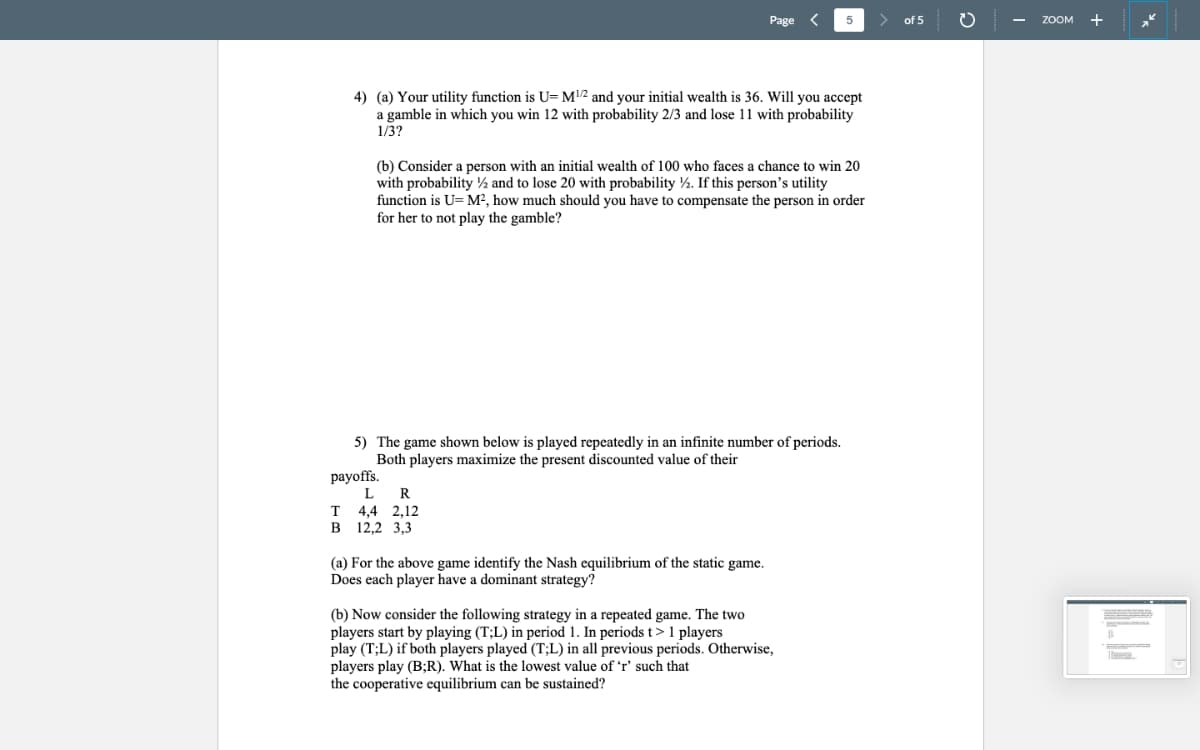4) (a) Your utility function is U- M¹/2 and your initial wealth is 36. Will you accept a gamble in which you win 12 with probability 2/3 and lose 11 with probability 1/3?
4) (a) Your utility function is U- M¹/2 and your initial wealth is 36. Will you accept a gamble in which you win 12 with probability 2/3 and lose 11 with probability 1/3?
Chapter7: Uncertainty
Section: Chapter Questions
Problem 7.7P
Related questions
Question
A6

Transcribed Image Text:Page
5
4) (a) Your utility function is U= M¹/2 and your initial wealth is 36. Will you accept
a gamble in which you win 12 with probability 2/3 and lose 11 with probability
1/3?
(b) Consider a person with an initial wealth of 100 who faces a chance to win 20
with probability and to lose 20 with probability 2. If this person's utility
function is U= M², how much should you have to compensate the person in order
for her to not play the gamble?
5) The game shown below is played repeatedly in an infinite number of periods.
Both players maximize the present discounted value of their
payoffs.
L
R
T 4,4 2,12
B 12,2 3,3
(a) For the above game identify the Nash equilibrium of the static game.
Does each player have a dominant strategy?
(b) Now consider the following strategy in a repeated game. The two
players start by playing (T;L) in period 1. In periods t > 1 players
play (T;L) if both players played (T;L) in all previous periods. Otherwise,
players play (B;R). What is the lowest value of 'r' such that
the cooperative equilibrium can be sustained?
of 5
O
ZOOM
+
wwwwwxx.com.com.com
Expert Solution
This question has been solved!
Explore an expertly crafted, step-by-step solution for a thorough understanding of key concepts.
This is a popular solution!
Trending now
This is a popular solution!
Step by step
Solved in 3 steps

Knowledge Booster
Learn more about
Need a deep-dive on the concept behind this application? Look no further. Learn more about this topic, economics and related others by exploring similar questions and additional content below.Recommended textbooks for you


Managerial Economics: A Problem Solving Approach
Economics
ISBN:
9781337106665
Author:
Luke M. Froeb, Brian T. McCann, Michael R. Ward, Mike Shor
Publisher:
Cengage Learning

Brief Principles of Macroeconomics (MindTap Cours…
Economics
ISBN:
9781337091985
Author:
N. Gregory Mankiw
Publisher:
Cengage Learning


Managerial Economics: A Problem Solving Approach
Economics
ISBN:
9781337106665
Author:
Luke M. Froeb, Brian T. McCann, Michael R. Ward, Mike Shor
Publisher:
Cengage Learning

Brief Principles of Macroeconomics (MindTap Cours…
Economics
ISBN:
9781337091985
Author:
N. Gregory Mankiw
Publisher:
Cengage Learning

Essentials of Economics (MindTap Course List)
Economics
ISBN:
9781337091992
Author:
N. Gregory Mankiw
Publisher:
Cengage Learning